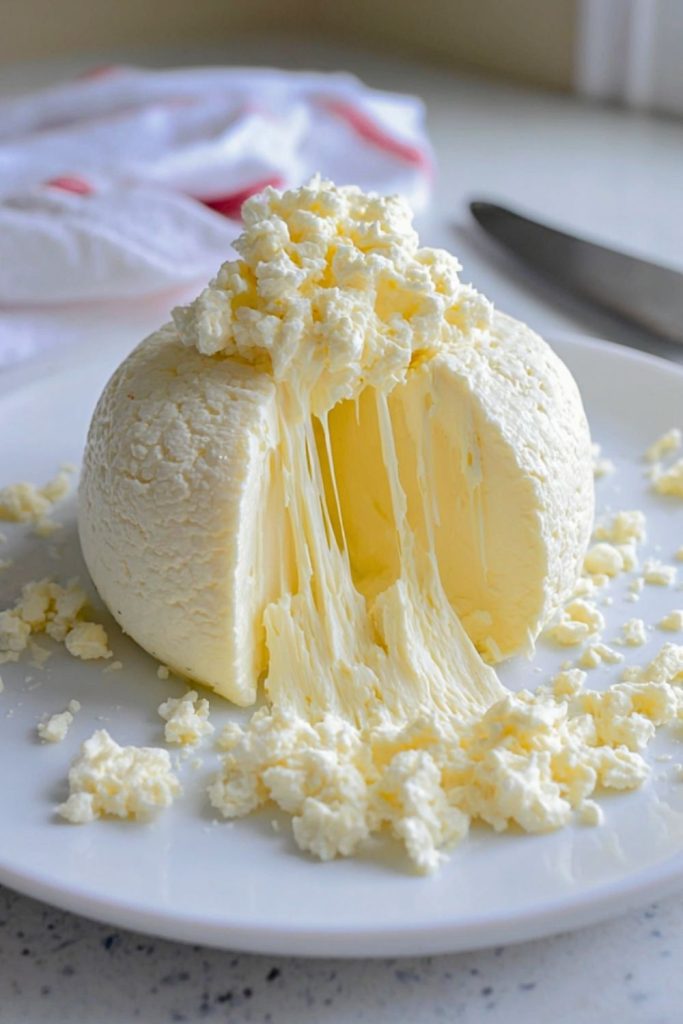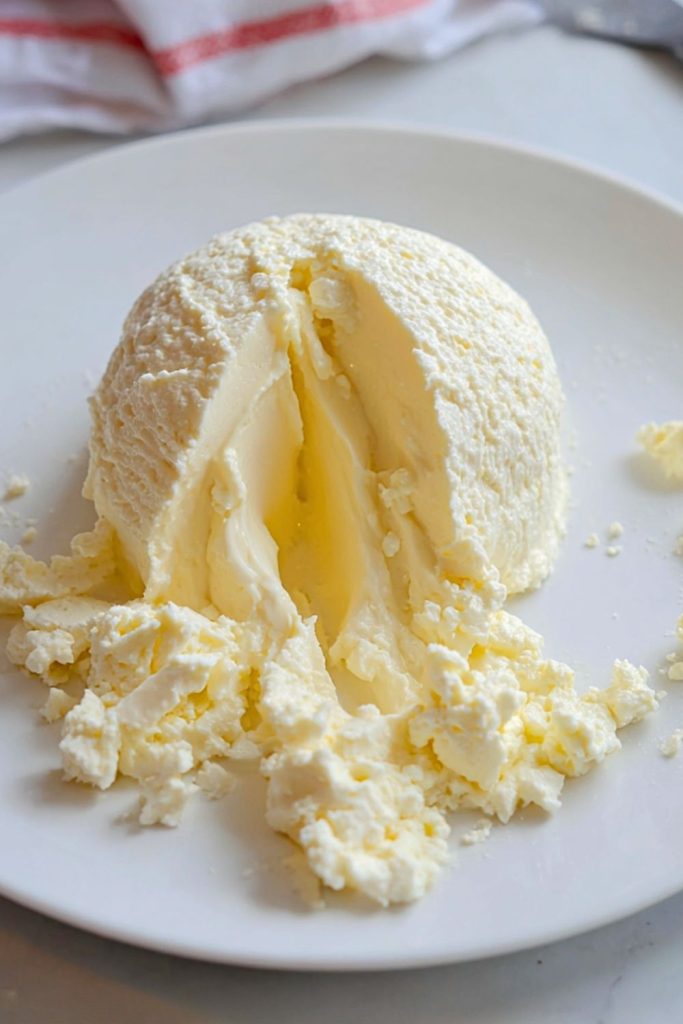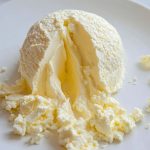I’ve always had a soft spot for simple, rustic recipes that deliver more than they promise—and Farmer’s Cheese is exactly that kind of food. It’s humble, made with minimal ingredients, and yet its creamy texture and mild tanginess always steal the show. Whether I’m spreading it over crusty bread, crumbling it onto a salad, or using it in a savory pie, Farmer’s Cheese adds that unmistakable homemade touch that store-bought cheeses just can’t replicate.

What makes this cheese special is how incredibly easy and satisfying it is to make. You don’t need any fancy equipment or hard-to-pronounce cultures—just milk, an acid like lemon juice or vinegar, and a bit of patience. Watching the curds form and come together is oddly therapeutic, and tasting that first fresh bite is always rewarding.
Why You’ll Love This Farmer’s Cheese
Farmer’s Cheese is a celebration of simplicity. It’s versatile, economical, and adaptable to both sweet and savory recipes. You’ll love how customizable it is—soft or crumbly, mild or tangy—and how quickly it comes together compared to aged cheeses. Whether you’re trying homemade cheese for the first time or revisiting a traditional favorite, this recipe is the perfect starting point.
What Kind of Milk Should I Use for Farmer’s Cheese?
The quality and type of milk you choose will significantly affect the flavor and texture of your Farmer’s Cheese. I always recommend using whole milk because it gives the richest, creamiest results. You can use pasteurized milk, but avoid ultra-pasteurized milk—it won’t curdle properly due to how it’s been processed. If you can get your hands on fresh raw milk, you’re in for an even more flavorful batch, but make sure it’s from a trusted source. Goat’s milk also works well if you’re looking for a slightly earthier flavor.
Options for Substitutions
If you don’t have exactly what the classic recipe calls for, no worries—Farmer’s Cheese is incredibly forgiving:
- Milk Substitutes: Goat’s milk, as mentioned, is a great alternative. Some have even had success with a blend of cow’s and sheep’s milk for a richer flavor.
- Acid Choices: Lemon juice gives a light, fresh tang, while white vinegar creates a slightly sharper flavor. Apple cider vinegar or even plain yogurt (as a culture starter) can also work.
- Salt Variations: Regular sea salt is the standard, but you can use kosher salt or leave it out entirely if you’re aiming for a sweet application.
These substitutions might slightly alter the end result, but that’s part of the fun—Farmer’s Cheese is very open to experimentation.
Ingredients for This Farmer’s Cheese
Whole Milk
This is the heart of Farmer’s Cheese. Whole milk has just the right amount of fat to give you a creamy texture and rich flavor. It also yields a good quantity of curds.
Acid (Lemon Juice or White Vinegar)
You’ll need an acid to help the milk curdle. Lemon juice gives the cheese a fresh, citrusy note, while vinegar offers a cleaner, sharper taste. Both work well, so it’s really about your personal preference.
Salt
A little salt enhances the flavor and brings out the natural richness of the cheese. You can adjust it to taste or omit it if you’re using the cheese for dessert-style recipes.
Water (Optional, for rinsing)
If you want a milder flavor, rinsing the curds briefly with water can help remove excess acidity or whey. This step is optional but useful for softer cheese textures.

Step 1: Warm the Milk
Pour the whole milk into a heavy-bottomed pot and set it over medium heat. Stir occasionally to prevent scorching and heat it slowly until it reaches about 180°F (82°C). You don’t need a thermometer, but look for gentle steam and tiny bubbles forming around the edges—not a boil.
Step 2: Add the Acid
Once the milk is hot, turn off the heat and immediately stir in your lemon juice or vinegar. Stir slowly for a few seconds, then stop. Let it sit undisturbed for about 5–10 minutes as the curds begin to form. You’ll see the milk separate into curds (solid white chunks) and whey (a yellowish liquid).
Step 3: Strain the Curds
Line a colander with cheesecloth or a clean, thin kitchen towel. Carefully ladle or pour the curds and whey into it. Let the liquid drain for at least 10–15 minutes. For firmer cheese, you can let it sit longer or gently squeeze the cloth to press out more whey.
Step 4: Season and Shape
Once drained to your liking, transfer the curds to a bowl and mix in salt, if using. You can use the cheese immediately or press it into a ball or mold for a neater presentation. Chill for at least an hour if you want it firmer and easier to slice or crumble.
How Long to Cook the Farmer’s Cheese
The actual “cooking” process is surprisingly quick. Heating the milk takes about 10–15 minutes, and once the acid is added, the curds begin forming almost immediately—within 5–10 minutes. Draining time can vary based on how soft or firm you want your cheese, typically ranging from 15 minutes for soft cheese to an hour for firmer, moldable cheese.
So in total, from start to finish, you’re looking at 30 to 60 minutes.
Tips for Perfect Farmer’s Cheese
- Use Fresh, High-Quality Milk: The better your milk, the better your cheese. Avoid ultra-pasteurized.
- Don’t Over-Stir After Adding Acid: Stirring too much can break the curds into tiny bits and lead to a grainy texture.
- Let It Sit Undisturbed: Once the acid is added, give the curds time to form without agitation.
- Adjust Drain Time to Your Texture Preference: Less draining yields a creamy, spreadable cheese; more draining gives you a firm, crumbly result.
- Taste Before Salting: Especially if you’re using the cheese in desserts or baking, you might want to skip the salt entirely.
Watch Out for These Mistakes While Cooking
- Using Ultra-Pasteurized Milk: It won’t curdle properly, leaving you with a disappointing yield.
- Overheating the Milk: Boiling can scorch the milk or result in rubbery curds. Aim for a gentle heat.
- Not Enough Acid: If your milk doesn’t separate well, you may need a bit more lemon juice or vinegar.
- Stirring Too Vigorously: This breaks up curds into small, grainy bits rather than nice fluffy clumps.
- Skipping the Rest Period After Acid: Letting the milk sit untouched is crucial for full curd development.
What to Serve With Farmer’s Cheese?
Crusty Bread or Sourdough
Spread fresh Farmer’s Cheese onto toasted slices for a rustic, satisfying snack.
Fresh Fruit or Berries
Pair with figs, strawberries, or peaches for a creamy-sweet contrast that’s perfect for breakfast or dessert.
Roasted Vegetables
Crumble the cheese over roasted beets, carrots, or squash for a rich, tangy finish.
Salads
Toss chunks of cheese into mixed greens, arugula, or a cucumber-dill salad.
Pierogies or Dumplings
Use Farmer’s Cheese as a filling for traditional Eastern European dishes like pierogies or vareniki.
Pasta Dishes
Mix it into warm pasta with herbs and garlic for a creamy, easy sauce alternative.
Savory Pies or Pastries
It’s excellent inside spanakopita, cheese borek, or other flaky, filled pastries.
Storage Instructions
Freshly made Farmer’s Cheese is best enjoyed within a few days, but with proper storage, it can last up to a week:
- Refrigerator: Store the cheese in an airtight container in the fridge for 5–7 days. Lining the container with a paper towel helps absorb any excess moisture.
- Freezing: Technically you can freeze it, but the texture becomes more crumbly and less creamy. If you must freeze it, wrap tightly in plastic and store in a freezer bag for up to 2 months.
- Avoid Exposure to Air: The cheese can dry out quickly, so keep it well-sealed.
Farmer’s Cheese does not age well—it’s meant to be enjoyed fresh!
Estimated Nutrition (Per 1/4 Cup Serving)
- Calories: ~100
- Protein: 6–7g
- Fat: 6g
- Saturated Fat: 4g
- Carbohydrates: 2–3g
- Sugars: 1g
- Sodium: ~80mg
- Cholesterol: ~20mg
- Fiber: 0g
These values can vary slightly depending on the type of milk and acid used. It’s a nutrient-rich, protein-packed ingredient that fits well into many diets.
Frequently Asked Questions
Can I use plant-based milk to make Farmer’s Cheese?
Unfortunately, no. Plant-based milks don’t have the same proteins required to form curds. Stick with dairy milk for this recipe.
How do I make the cheese more or less tangy?
To adjust the tanginess, choose your acid wisely—lemon juice for milder, vinegar for sharper. You can also reduce the amount slightly for a subtler flavor.
What should the curds look like when they’re ready?
They should be soft, white, and clearly separated from the yellowish whey. The texture is similar to ricotta or small cottage cheese curds.
Is it okay if my cheese smells sour?
A light tangy smell is normal due to the acid, but if it smells off or unpleasantly sour after a day or two, it may be spoiled.
Can I flavor the cheese with herbs or spices?
Absolutely! Try mixing in fresh dill, chives, cracked black pepper, or even garlic for a savory twist.
What should I do with the leftover whey?
Whey is packed with nutrients. Use it in smoothies, soups, bread baking, or feed it to plants as a fertilizer.
Why didn’t my milk curdle properly?
This often happens with ultra-pasteurized milk or not enough acid. Make sure you’re using whole, non-ultra-pasteurized milk and add enough lemon juice or vinegar.
Can I double the recipe?
Yes, just scale the ingredients proportionally and make sure your pot is large enough. The method stays the same.
Conclusion
Farmer’s Cheese is a beautiful reminder that you don’t need complexity to create something truly delicious. I find it incredibly satisfying to make—a blend of craft, comfort, and tradition in one simple process. Whether you use it fresh with fruit, melt it into a savory pastry, or spread it on toast, this cheese will quickly earn a permanent place in your kitchen. Give it a try—you might be surprised how often you’ll find yourself making it.

Farmer’s Cheese
- Prep Time: 5 minutes
- Cook Time: 15 minutes
- Total Time: 30-60 minutes
- Yield: 1 cup
- Category: Cheese
- Method: Stovetop
- Cuisine: Homemade
- Diet: Vegetarian
Description
Farmer’s Cheese is a soft, fresh, homemade cheese made by curdling whole milk with an acid like lemon juice or vinegar. It’s creamy, tangy, and incredibly versatile—perfect for spreading, crumbling, or using in both sweet and savory dishes.
Ingredients
4 cups whole milk
2 tablespoons lemon juice or white vinegar
1/4 teaspoon salt (optional)
Water for rinsing (optional)
Instructions
1. Heat the milk in a saucepan over medium heat until it reaches 180°F or starts to steam with small bubbles at the edges.
2. Remove from heat and stir in the lemon juice or vinegar. Stir gently for a few seconds, then let it sit undisturbed for 10 minutes.
3. Line a colander with cheesecloth and place it over a bowl. Pour the curds and whey into the colander.
4. Let the cheese drain for 15 to 60 minutes depending on desired texture.
5. Transfer the curds to a bowl and mix in salt if using.
6. Use immediately or chill for an hour to firm it up before serving.
Notes
Store in an airtight container in the fridge for up to 7 days. For a milder flavor, rinse the curds with cold water before salting. Use leftover whey in smoothies, soups, or bread dough for added nutrients.
Nutrition
- Serving Size: 1/4 cup
- Calories: 100
- Sugar: 1
- Sodium: 80
- Fat: 6
- Saturated Fat: 4
- Unsaturated Fat: 1
- Trans Fat: 0
- Carbohydrates: 3
- Fiber: 0
- Protein: 7
- Cholesterol: 20
Keywords: farmer’s cheese, homemade cheese, fresh cheese

